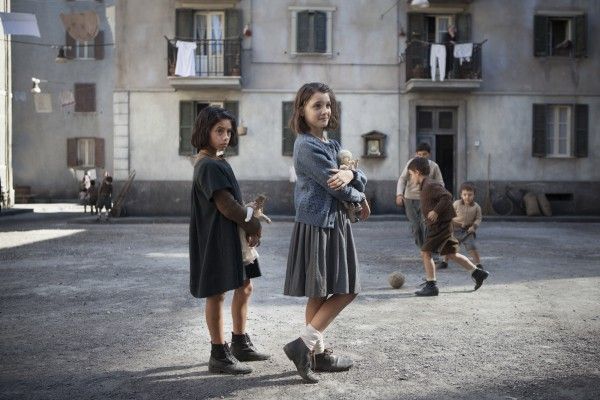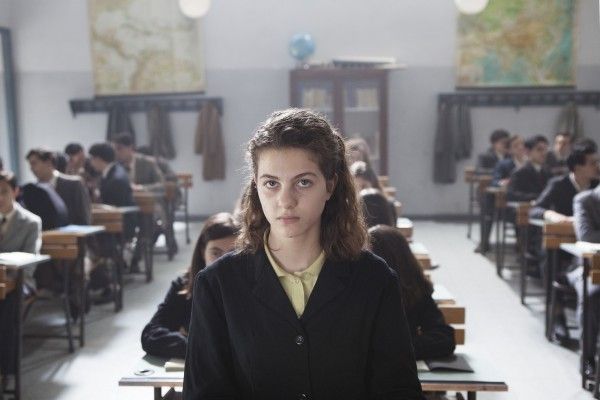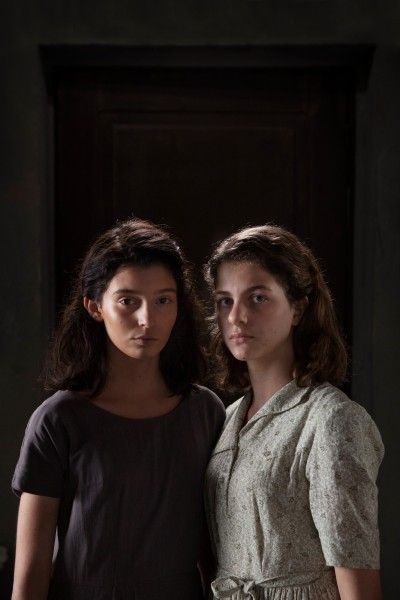“She always did the things I was supposed to do faster and better,” says Elena “Lenù” Greco of her best friend, Raffaella “Lila” Cerullo. The relationship at the center of HBO’s eight-part miniseries My Brilliant Friend understands the complexity of loving someone and still being jealous of them, of competing while also feeling drawn to protect them. Such is the back and forth in the friendship between Lenù and Lila, starting when they are children and continuing through their teenage years in a small, sooty neighborhood outside of Naples. The miniseries—a coproduction with Italy’s RAI and TIMvision—is based on the wildly popular work of Italian author Elena Ferrante, and directed by Saverio Costanzo. It is the study of bright young girls at their best and very worst, in ways that also reflect the oppressive 1950s culture around them, one which doesn’t understand or have room for such smart, talented girls.
From the start, Lila (played as a child by Ludovica Nasti and as a teenager by Gaia Girace) is painted as an antagonistic personality. She’s a difficult to get along with, routinely taunting other students and never afraid to get into a fight or throw rocks at the boys who she beats academically as well. “She’s firm,” as Lenù describes (Lenù is played by Elisa Del Genio as a child and Margherita Mazzucco as a teenager), which is a strange thing to say about a young girl, and yet, also very true of Lila. As the two girls become hesitant friends, Lila is always challenging Lenù, encouraging her in boldness. And yet, for much of those early episodes (and often later as well), the girls—especially Lenù— are observers more than participants, especially when it comes to the messy, dramatic lives of their families and those in their neighborhood.
Far from the idyllic portrayals of the 1950s in most American series, My Brilliant Friend explores the working poverty of the neighborhood where the girls live in. There is one family who prospers, and after a murder (with a questionable arrest), another who flourishes in their place. As the girls grow up, they hear tell of a black market or contraband from a charmingly proud communist friend, but the nefarious dealings of this wealthy family, the Solarases, can simply be seen in the way the sons treat women, as well as their violent actions against their neighbors. Violence is everywhere in My Brilliant Friend, from bullying and beatings to the fallouts from affairs and shouting matches among family members. Much of the violence is aimed towards women, sometimes from the hands of other women, but more often from fathers and brothers and occasionally men who feel it is their right to never be denied.
What makes My Brilliant Friend really stand out though is how it focuses on the inner lives of its female leads, girls who distinguish themselves not by their beauty or charm, but by their intelligence. In that, they are defiant. Without Lila, Lenù would have undoubtedly been the star of her neighborhood, but everyone knows that Lila is always slightly better than she is. She’s smarter, quicker, more ambitious, and later has more boys who are interested in her. And yet, Lenù is drawn to her and fiercely protective of their friendship, and Lila feels the same way. Things take a turn when Lila is no longer allowed to attend school, and must instead work with her father, a shoemaker, to bring in money. Lenù’s parents reluctantly allow her to continue with school only if she is “the best” in her class, and so she studies hard to make that so. The pressure on both girls continues to build in different ways, and causes a constant shift in the dynamics of their relationship.
My Brilliant Friend is not always as dynamic, however. The teenagers here feel very real, which is to say that they are not like the sleek, quippy, scheming stars of a teen drama, but rather sullen, conflicted, hesitant, and often inert. (Lenù, horribly and wonderfully, deals with breakouts and confusion over her period, and is wracked with insecurities.) Smiles are exceedingly rare. But they both retain a sweetness, too, even the “firm” Lila; there’s an innocence that remains even as the girls witness life-altering things. It’s often in contrast with the miniseries’s voiceover, from an older Lenù’s perspective (the series uses a framing device of a 60-year-old Lenù looking back on her childhood with Lila), as the descriptions of what’s happening don’t usually match the tone of what we see, or don’t add to it.
But Costanzo does create a very intimate portrait of life in this particular place at this particular time, all of which takes place in small, deliberate, often confined spaces. The story is easy to get swept up into, in regards to the rhythms of its language and the cyclical nature of its challenges. Their struggles feel both relatable and totally foreign all at once. The set of actresses who portray Lenù and Lila are also endlessly interesting, putting their characters at wide-eyed (or smoldering, glaring) odds with a stressful world where they are (particularly Lila) trapped by the small-mindedness of traditionalists who refuse to move forward. Lila’s arcs tend to be more dynamic than Lenù, the perpetual observer, but the New Wave-y feel of the story and the cozy locales make us engaged observers too, ones who are given a peek into a postwar world and a unique point of view that can be challenging but also well worth exploring.
Rating: ★★★★
My Brilliant Friend premieres Sunday, November 18th on HBO, and continues on Monday, November 19th.




